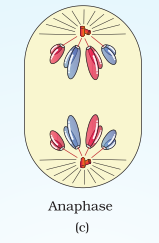This is the most dramatic period of the cell cycle, involving a major reorganisation of virtually all components of the cell. Since the number of chromosomes in the parent and progeny cells is the same, it is also called as equational division. Though for convenience mitosis has been divided into four stages of nuclear division (karyokinesis), it is very essential to understand that cell division is a progressive process and very clear-cut lines cannot be drawn between various stages. Karyokinesis involves following four stages:
- Prophase
- Metaphase
- Anaphase
- Telophase
Prophase

Prophase which is the first stage of karyokinesis of mitosis follows the S and G2phases of interphase. In the S and G2phases the new DNA molecules formed are not distinct but intertwined. Prophase is marked
by the initiation of condensation of chromosomal material. The chromosomal material becomes untangled during the process of chromatin condensation (as per side Figure a). The centrosome, which had undergone duplication during S phase of interphase, now begins to move towards opposite poles of the cell. The completion of prophase can thus be marked by the following characteristic events:
- Chromosomal material condenses to form compact mitotic chromosomes. Chromosomes are seen to be composed of two chromatids attached together at the centromere.
- Centrosome which had undergone duplication during interphase, begins to move towards opposite poles of the cell. Each centrosome radiates out microtubules called asters. The two asters together with spindle fibres forms mitotic apparatus.
Cells at the end of prophase, when viewed under the microscope, do not show golgi complexes, endoplasmic reticulum, nucleolus and the nuclear envelope.
Metaphase

The complete disintegration of the nuclear envelope marks the start of the second phase of mitosis, hence the chromosomes are spread through the cytoplasm of the cell.
By this stage, condensation of chromosomes is completed and they can be observed clearly under the microscope. This then, is the stage at which morphology of chromosomes is
most easily studied. At this stage, metaphase chromosome is made up of two sister chromatids, which are held together by the centromere (as per side Figure b). Small disc-shaped structures at the surface of the centromeres are called kinetochores. These structures serve as the sites of attachment of spindle fibres (formed by the spindle fibres) to the chromosomes that are moved into position at the centre of the cell. Hence, the metaphase is characterised by all the chromosomes coming to lie at the equator with one chromatid of each chromosome connected by its kinetochore to spindle fibres from one pole and its sister chromatid connected by its kinetochore to spindle fibres from the opposite pole (as per side Figure b). The plane of alignment of the chromosomes at metaphase is referred to as the metaphase plate. The key features of metaphase are:
- Spindle fibres attach to kinetochores of chromosomes.
- Chromosomes are moved to spindle equator and get aligned along metaphase plate through spindle fibres to both poles.
Anaphase

At the onset of anaphase, each chromosome arranged at the metaphase plate is split simultaneously and the two daughter chromatids, now referred to as daughter chromosomes of the future daughter nuclei, begin their migration towards the two opposite poles. As each chromosome moves away from the equatorial plate, the centromere of each chromosome remains directed towards the pole and hence at the leading edge, with the arms of the chromosome trailing behind (as per side Figure c). Thus, anaphase stage is characterised by the following key events:
- Centromeres split and chromatids separate.
- Chromatids move to opposite poles.
Telophase

At the beginning of the final stage of karyokinesis, i.e., telophase, the chromosomes that have reached their respective poles decondense and lose their individuality. The individual chromosomes can no longer be seen and each set
of chromatin material tends to collect at each of the two poles (as per side Figure d). This is the stage which shows the following key events:
- Chromosomes cluster at opposite spindle poles and their identity is lost as discrete elements.
- Nuclear envelope develops around the chromosome clusters at each pole forming two daughter nuclei.
- Nucleolus, golgi complex and ER reform.
Cytokinesis

Mitosis accomplishes not only the segregation of duplicated chromosomes into daughter nuclei (karyokinesis), but the cell itself is divided into two daughter cells by the separation of cytoplasm called cytokinesis at the end of which cell division gets completed (as per side Figure e). In an animal cell, this is achieved by the appearance of a furrow in the plasma membrane. The furrow gradually deepens and ultimately joins in the centre dividing the cell cytoplasm into two. Plant cells however, are enclosed by a relatively inextensible cell wall, thererfore they undergo cytokinesis by a different mechanism. In plant cells, wall formation starts in the centre of the cell and grows outward to meet the existing lateral walls. The formation of the new cell wall begins with the formation of a simple precursor, called the cell-plate that represents the middle lamella between the walls of two adjacent cells. At the time of cytoplasmic division, organelles like mitochondria and plastids get distributed between the two daughter cells. In some organisms karyokinesis is not followed by cytokinesis as a result of which multinucleate condition arises leading to the formation of syncytium (e.g., liquid endosperm in coconut).
